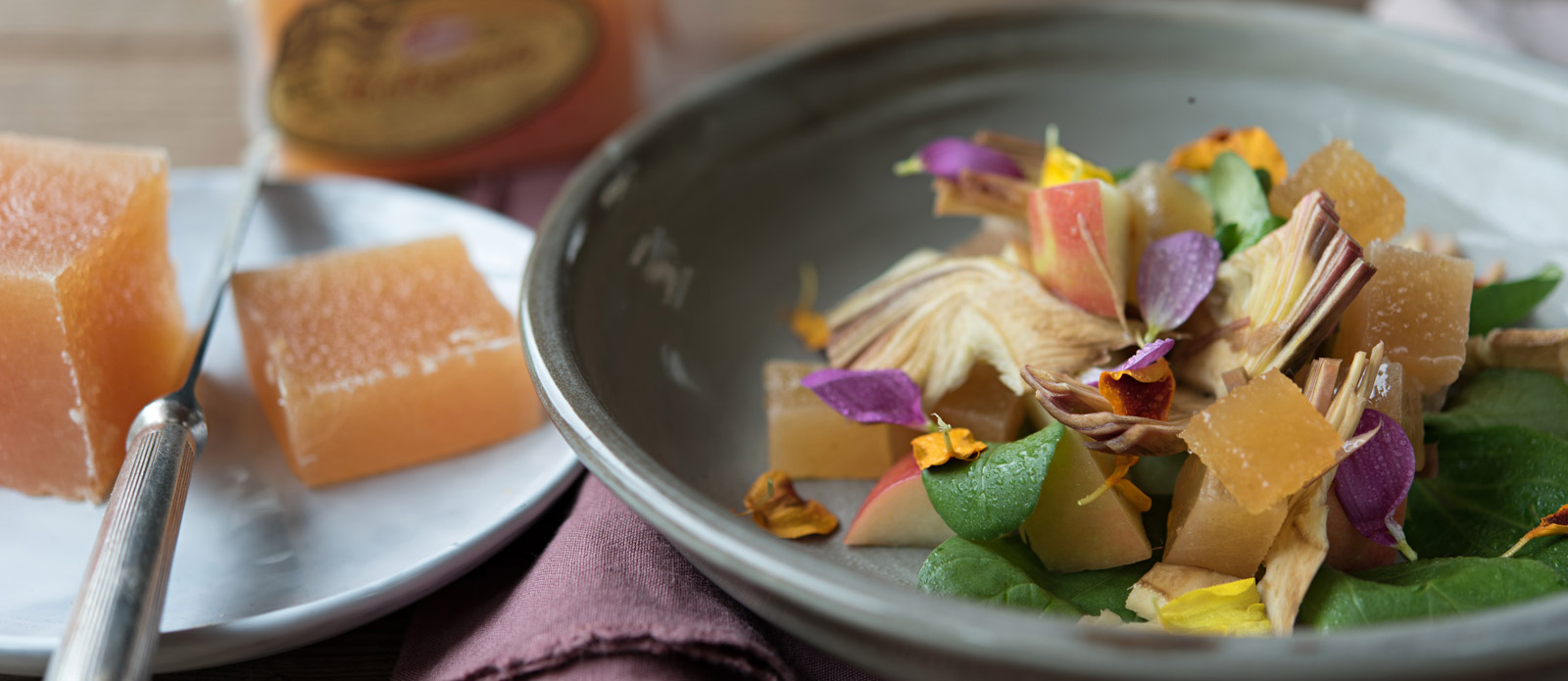Quince jelly

Index:
- Let’s discover quinces
- Quince jelly, recipe and preparation
- Quince jelly ingredients
- Different type of quince jelly in Italy
- Sicilian quince jelly
- Lecce’s quince jelly
- How to eat quince jelly
- How to preserve quince jelly
- Quince jelly properties and nutritional benefits
Let’s discover quinces
Quinces are some very particular fruits: big and with an irregular shape, they are very fragrant, but they can’t be eaten raw because of their very tart taste.
Generally, people think that quinces are a sort of a hybrid between apples and pears, well, they are totally wrong. The Italian name for quince tree is cotogno: it belongs to the Rosaceae family, the same of apple trees and pear trees, but it is classified under the genus Cydonia, which is a very different plant subspecies.
Quince tree has a very ancient history: the Babylonians and the Greeks used to grow it, it is one of the oldest known fruit trees. It spread all over Asia Minor and Caucasus, and started to grow also in the Mediterranean area. Italy is one of the countries where quince trees find a very fertile soil to root, we can find some places where they grow spontaneously.
Italian peasant families used quinces as freshener for their wardrobes, until they thought to cook them adding sugar in order to neutralize their sour taste. That’s how quince jelly was born, a very peculiar kind of apple jam with a firm consistency, born in the kitchen of the farmers in northern Italy it is actually become a recipe of the Italian tradition.
Quince jelly, recipe and preparation
How do we prepare a traditional quince jelly? There are plenty of recipes to prepare this dessert, because over time every region made its own quince jelly, adding some secret ingredients or changing something.
Here some steps to prepare an excellent homemade quince jelly, following the traditional recipe that we still use to prepare our quince jelly:
- Quince jelly must be prepared only with ripe quinces. Cut them into quarters, and remove the core, seeds and the soft furry coating, even if they normally lose their fuzz when they are ripe.
- Put the quince slices into a saucepan with some lemon juice, add water before turning on the fire to cook them. Put them to a boil and cook the quinces until the skin will be soft.
- Once properly cooked, drain and sift the quinces. Then cook them again: this time you have to put the quinces in a saucepan with the same amount in weight of sugar. Boil the quinces with sugar, always carefully stirring to prevent your preparation from sticking to the pan. Once the preparation comes to a boil, continue cooking on a low flame for twenty more minutes, stir well because the quince jelly need to keep its liquid consistency. Until now, the process is very similar to the one used to prepare a normal apple jam.
- Pour the warm and liquid quince jelly into the moulds you prefer, make sure to wet the moulds with water before pouring the quince mix into them. Let rest your quince jelly in the moulds for a few days in a fresh and dry place.
- After a few days, you can remove the quince jelly from the moulds, and let it rest again until the external part forms its typical sugar crust. The important thing is to let it sit in a fresh and airy place. You just have to wait a few days before enjoying your homemade quince jelly.
Quince jelly ingredients
Which are the quince jelly ingredients? Same amount in weight of quinces and sugar, water and lemon juice. As we have already said, there are many other regional reinterpretations of quince jelly, changing the recipe with some ingredients or with a few more steps during the preparation. This results in a softer or harder quince jelly or a higher or lower sweetness level.
Different type of quince jelly in Italy
Italy proposes different versions of the quince jelly recipe: let’s discover the most famous ones and what changes from the traditional recipe. In the Emilian Apennines, people use to apply with a brush a bit of grappa on the surface of the dessert.
In some Italian northern areas, they use to prepare a spicy quince jelly. It is the same preparation of the classic quince jelly, except that they add some spices with a very intense flavor while cooking: cloves, cinnamon, pepper and a pinch of mustard, in different quantities depending on everyone’s taste.
The most famous Italian quince jellies are without any doubt the Sicilian version and the Lecce’s one, to which we dedicate 2 special places.
Sicilian quince jelly
The preparation of the Sicilian quince jelly is slightly different from the recipe written above. In this case, we prepare a quince jam, peeling the fruit and cooking only the pulp with the lemon.
Do not through away skin and cores. Cook them with some water for 45 minutes. Sift the pulp in order to remove any lemon piece, before cooking again. Add sugar, in the same amount of weight, and the preparation resulted from the cooking of cores and skins. Then continue cooking following the traditional recipe.
Sicilian quince jelly moulds have also a very peculiar form: they are curved and decorated with flowers, fruits or other symbols representing the region. In the area near Syracuse – home town for the traditional Sicilian quince jelly – it is often served at the end of the meal as single serving dessert.
Lecce’s quince jelly
The Lecce’s quince jelly is another famous preparation you can make with quinces and it belongs to the most prized products in the Salento region. Ingredients and procedure are not so different from the ones described in the recipe here above, even if in the most part of homemade recipes they use a lower amount of sugar.
To prepare a Lecce’s quince jelly, the amount of sugar varies from 500 to 750 grams per quince kilo, depending on the sweetness level of the dessert you want to obtain. Furthermore, many recipes suggest cooking sugar and quince in two different saucepans.
Melt the sugar with a bit of water and caramelize it in a pan, then add quinces, which should have been already cooked with water and lemon. To complete the preparation, use a spoon to energetically stir the mixture, until it gains the typical red-brown colour of the Lecce’s quince jelly.
Quince jelly is one of the most typical desserts in the Salento area, you can taste it just as it is or with some biscuits or some homemade taralli.
How to eat quince jelly
Italians use to eat quince jelly as it is, tasting it as a dessert at the end of the meal or as a delicious snack. However, nowadays we find quince jelly also in some other particular pairings.
Someone has a snack with quince jelly, someone else eats it with a slice of bread, just as any other fruit jam, although it will not be easy to spread. Always more often it is proposed for some savory pairings, especially with both cow and goat’s milk mature cheeses. It may be sound bizarre to pair a jam with a savory dish, but you have to try it to discover its extraordinary taste: prepare some skewers alternating pecorino cubes and quince jelly and serve among the appetizer of an exquisite buffet!
For those who want to try an unusual pairing and a new taste, try quince jelly in a colorful salad made with artichokes, apples and valerian: taste it to believe it!
How to preserve quince jelly
As regards its preservation, you just need to follow a few rules and your quince jelly will preserve its consistence and tastiness for a long time.
What is important is to keep dry the quince jelly chunks. One of the oldest – nonetheless effective – suggestions concerning its preservation says to place quince jelly in a metal box with a handful of dry bay leaves.
Another effective solution consists in wrapping every single piece of quince jelly in plastic, putting them in a metal box and preserve it in a fresh, dry and dark place. In this way quince jelly will keep for several months.
Quince jelly properties and nutritional benefits
Quinces are known for their beneficial properties treating some intestinal diseases: during the Middle Age and the Renaissance, doctors suggested to drink quince juice when experiencing some enteric disorders.
Raw quinces are rich in vitamin C, which got lost while cooking the quince jelly. Anyway, this delicious dessert is rich in fibres, but contains a big amount of sugar, an essential ingredient to prepare quince jelly. 100 grams of quince jelly contain approximately 200 calories: a quite high intake of calories, which must be relate to the normally eaten quantity, which normally is just a few dozen grams.

